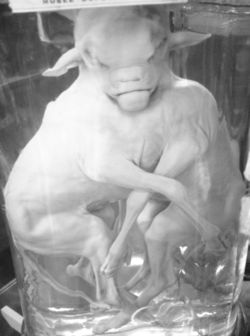
Musée Dupuytren
Encyclopedia

Paris
Paris is the capital and largest city in France, situated on the river Seine, in northern France, at the heart of the Île-de-France region...
, France
France
The French Republic , The French Republic , The French Republic , (commonly known as France , is a unitary semi-presidential republic in Western Europe with several overseas territories and islands located on other continents and in the Indian, Pacific, and Atlantic oceans. Metropolitan France...
, and open weekdays except holidays and university vacations. The closest métro stations are Cluny – La Sorbonne and Odéon
Odéon (Paris Metro)
Odéon is a station on lines 4 and 10 of the Paris Métro in the 6th arrondissement in the heart of the Left Bank.The station was opened on 9 January 1910 as part of the connecting section of the line under the Seine between Châtelet and Raspail. The line 10 platforms opened on 14 April 1926 as part...
.
The museum was established in 1835 by Mathieu Orfila
Mathieu Orfila
Mathieu Joseph Bonaventure Orfila was a Spanish-born French toxicologist and chemist, the founder of the science of toxicology.- Role in Forensic Toxicology :...
as the Museum of Pathological Anatomy of the Medicine Faculty of the University of Paris
University of Paris
The University of Paris was a university located in Paris, France and one of the earliest to be established in Europe. It was founded in the mid 12th century, and officially recognized as a university probably between 1160 and 1250...
, with the bequest of Baron Guillaume Dupuytren
Guillaume Dupuytren
Guillaume Dupuytren, Baron was a French anatomist and military surgeon. Although he gained much esteem for treating Napoleon Bonaparte's hemorrhoids, he is best known today for Dupuytren's contracture which is named after him and which he described in 1831.- Birth and education :Guillaume...
, anatomist and celebrated professor of surgery. The museum was installed in the old refectory of the Cordeliers Convent
Cordeliers Convent
The Cordeliers Convent was a convent in Paris, France.It gave its name to the Club of the Cordeliers, which held its first meetings there during the French Revolution....
, gathering collections from throughout the faculty. Its first catalog was compiled between 1836 and 1842, and listed about a thousand specimens. By the late 1870s the museum contained over six thousand pieces.
The museum began a slow decline starting in the late 19th century, despite continued acquisition of new collections, and its upkeep became problematic. In 1937 Gustave Roussy
Gustave Roussy
Gustave Roussy was a Swiss-French neuropathologist who was born in Vevey, Switzerland.-Career:As interne des hôpitaux in Paris, Roussy worked under neurologists Pierre Marie and Joseph Jules Dejerine, and in 1907 earned his doctorate from the University of Paris...
ordered the museum shut, with many items subsequently lost or destroyed. However in 1967 Jacques Delarue (1901–1971) brought the museum back to life with a general refurbishment. Today it still retains a superb collection, including specimens dating from the 17th century, as well as wax anatomical models, books, and photographs.
Among many other notable items, the museum contains brain
Brain
The brain is the center of the nervous system in all vertebrate and most invertebrate animals—only a few primitive invertebrates such as sponges, jellyfish, sea squirts and starfishes do not have one. It is located in the head, usually close to primary sensory apparatus such as vision, hearing,...
s of aphasic
Aphasia
Aphasia is an impairment of language ability. This class of language disorder ranges from having difficulty remembering words to being completely unable to speak, read, or write....
patients, preserved in alcohol by the celebrated anatomist Paul Pierre Broca, and used in his research in the localization of brain functions.

